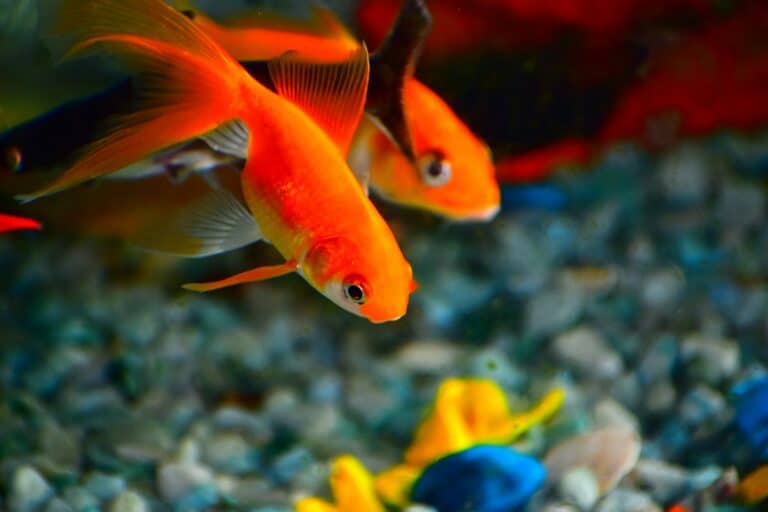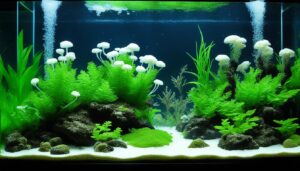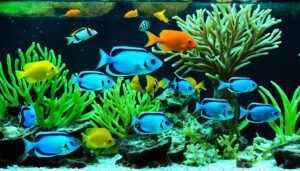If you’re into goldfish like me, then you know their health is super important. But here’s something not everyone gets: they really need a big, clean tank to thrive. Goldfish aren’t meant for those tiny bowls! When they’re young, they need at least 20 gallons of water per fish, and once they grow, they’ll need way more — think 50 to 75 gallons. These guys can get up to 14 to 16 inches long, so it’s clear a little bowl just doesn’t cut it.
Keeping them healthy is all about prevention and quick action when things go wrong. I’ve picked up some solid tips from experts like Dr. Jessie Sanders on spotting early signs of trouble. We’ll dive into everything from cloudy eyes to neurofibromas, plus the sneaky parasites they might bring home from the pet store.
Since goldfish can’t tell us when something’s off, it’s all about watching closely. If they’re swimming slower than usual or have red streaks, it’s time to step in. But the good news is, with a little know-how on common goldfish issues and how to maintain their water, you can keep them happy and healthy.
Let’s get into the nitty-gritty of aquatic care, from keeping your tank spotless to handling any health hiccups. With the right attention, these little guys can stick with you for up to 30 years. They’re not just pets—they’re lifelong companions. Ready to dive in? Let’s go!
Poor Water Quality and Its Impact on Goldfish Health

If you love aquariums as I do, you know clean water is key to prevent goldfish diseases. Dirty water makes it easy for diseases to spread and hurts your goldfish’s health. Checking and keeping the water clean is essential to caring for sick goldfish. This helps them get better faster and stronger.
Ammonia and nitrites must always be zero in a good aquarium. These harmful substances can cause serious health issues or even kill goldfish. A steady pH level from 7.0 to 8.0 is also vital. Without it, goldfish can get very stressed and sick, showing goldfish illness symptoms.
Using tools like Coralife Turbo-Twist UV Sterilizers can make a big difference in your tank. They kill bad pathogens and algae, making a safer home for your goldfish. Changing the UV sterilizer lamps regularly keeps these devices working well. This helps stop goldfish diseases.
Quarantining new fish for at least 30 days is a strategy I recommend. It prevents diseases from spreading to your other fish. This time allows any hidden illnesses to be treated alone, protecting your aquarium’s health.
- Regular water chemistry tests to ensure zero ammonia and nitrites.
- Stable pH maintenance to avoid stress and consequent health issues.
- Use of UV sterilizers to maintain clean and disease-free water.
- Quarantine new fish to prevent spread of diseases to the tank.
Dr. Jessie Sanders talks about how important good water quality is for goldfish health. Bad water can lower their immune system, hurt their ability to have babies, and stop them from growing. This is why it’s so important to prevent problems.
From what I’ve seen, these approaches don’t just help goldfish. They can turn a regular tank into a vibrant aquatic world. Staying on top of tank care and focusing on goldfish health can really help. It makes it far more likely for your goldfish to stay happy and healthy.
Common Goldfish Diseases: Symptoms and Diagnoses
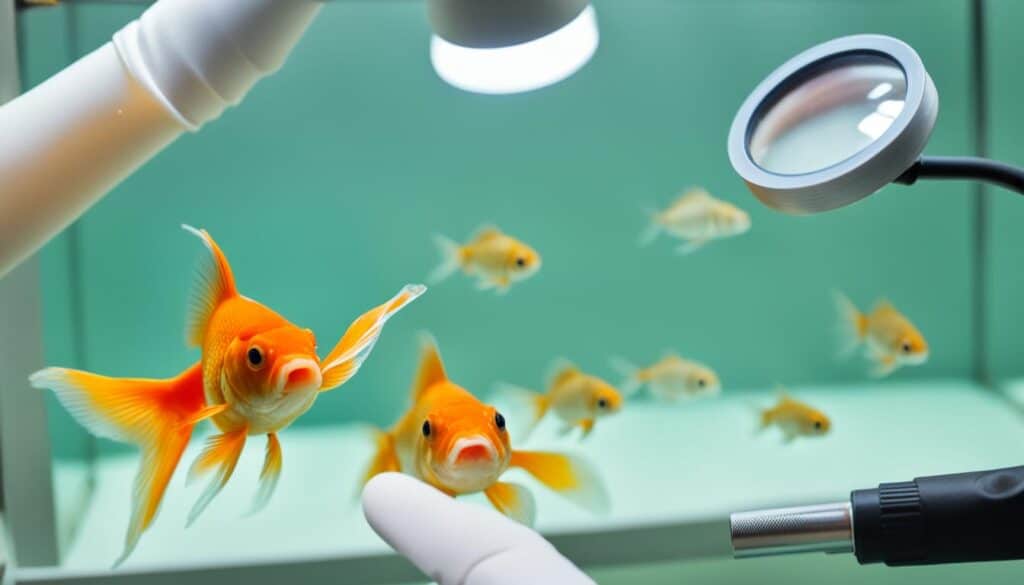
If you love aquatic pets, spotting fish diseases early is key. Early detection helps in the effective management and treatment of common goldfish diseases. Look out for signs like odd swimming, tiredness, and physical changes to avoid worse health problems.
- Swollen Belly/Dropsy: A swollen belly often means kidney issues, which can be deadly. It’s vital to quickly see a specialist since there is a high chance of kidney failure.
- Neurofibroma: These non-cancerous tumors need surgery under anesthesia for the best chances of success.
- Fluke: Spotting this parasite needs a microscopic look. Treatment typically includes medication like Droncit and keeping the fish away from others to stop the spread.
- Anchor Worms: Removing these with tweezers and giving salt baths helps. It’s important to check and quarantine new fish to avoid them.
- Fin Rot: With worsening fin condition, treat with non-iodized salt baths and trim damaged fins carefully.
Disease |
Signs |
Recommendations |
|---|---|---|
Ulcers |
Pink/red open sores, can be deadly if not treated |
Quick action is crucial to avoid death |
Ich |
Affects fish with weak immune systems from bad water |
Keep water perfect and quarantine new fish |
Chilodonella |
Shows up when a fish’s immune system is down, often from stress |
Ensure great water quality, lessen stress |
Dealing with tropical fish diseases involves quick medical action and responsible pet care. This means keeping water clean and isolating new fish properly. Always get help from experts like Dr. Jessie Sanders for the right treatment, instead of just using over-the-counter remedies.
Parasitic Infections in Goldfish
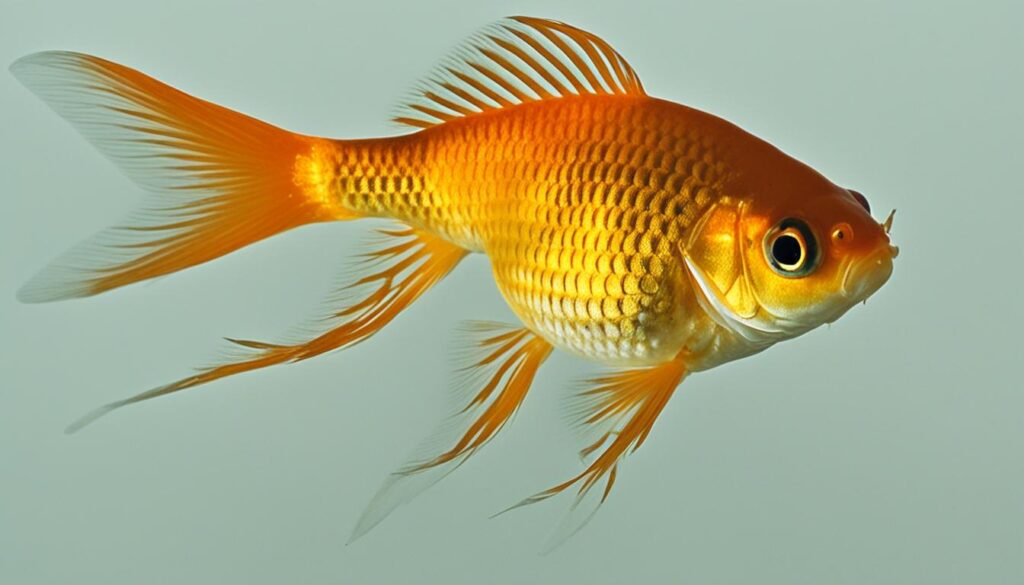
Bringing home a new fish from the store might also mean bringing in some unwanted parasites that could mess with your goldfish’s health. These parasites can sneak in through the water or even equipment, which could lead to an outbreak if you’re not careful. That’s why catching signs of parasites early—like bruising or a fish looking more sluggish than usual—is super important when treating your goldfish.
One of the best ways to prevent these common diseases is by quarantining any new fish for about two weeks. This little isolation period can really cut down the chance of parasites spreading to your main tank. On top of that, make sure to keep your water in tip-top shape. Regularly check things like pH and ammonia levels to create a healthy environment for your goldfish.
Treatment Recommendation |
Substance Composition |
Application Method |
|---|---|---|
Aquarium Salt Treatment |
1 tablespoon per gallon |
Administer over 12 hours, observe for signs of recovery. |
Antiparasitic Mixture |
1.5% Methylene Blue, 0.1% Malachite Green, 0.05% Acriflavine, 0.04% Quinine |
One drop per liter of aquarium water |
Water Conditioner |
API Stress Coat Water Conditioner |
Add to provide a protective coating for fish and detoxify metals |
- Regularly check for symptoms like lack of appetite, open sores, and unusual swimming patterns.
- Do a 50% water change if tests show low pH or high ammonia, repeating until levels stabilize.
- Introduce treatments like salt and specialized antiparasitic mixtures after consulting with a vet or an experienced aquarist.
- Consider a complete aquarium strip-down if a severe parasitic infection is confirmed.
To effectively treat sick goldfish, keep their surroundings clean and stress-free. Remember, maintaining a clean tank and watching closely are your top methods to avoid common goldfish diseases.
Goldfish Lumps (Neurofibromas)
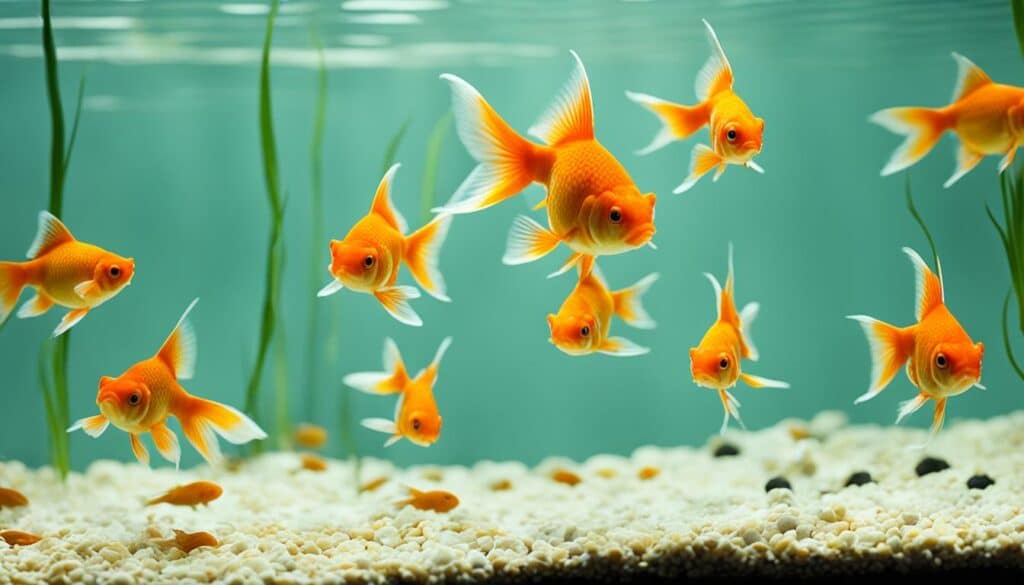
Learning about goldfish lumps, such as neurofibromas, is important for goldfish owners. These are benign tumors and usually don’t threaten your fish’s health.
Neurofibromas grow in the skin’s nerves, which makes removing them hard. They might cause some pain near the eyes or mouth but don’t interfere with normal fish activities.
It’s critical to know the difference between harmful lumps and benign neurofibromas. Bad symptoms may mean the lump needs to come out. Even so, experts warn that surgery can be risky and may not stop the lumps from coming back.
Treatment |
Effectiveness |
Notes |
|---|---|---|
Cryotherapy |
Temporary relief |
May not prevent regrowth |
Surgical Removal |
Varies |
Recommended only if lumps hinder basic functions |
Silver Nitrate Application |
Post-surgery |
Helps treat deeper tissue layers after lump removal |
Watching over your goldfish is key. Noting any lump changes is vital. Always talk to a fish expert about how to best care for your goldfish.
Buoyancy Disorder

Goldfish buoyancy disorder affects how goldfish swim and stay balanced. It’s crucial to understand, diagnose, and treat sick goldfish for their wellbeing.
When goldfish struggle with this, they might float to the top or sink to the bottom. It’s often due to a swim bladder disease. Fancy goldfish are more at risk because of their body shapes. Taking care of them requires both immediate and long-term care.
Several factors such as water quality, diet, and genetics are important. Bad water conditions and the wrong diet can hurt their swim bladder. It’s best to keep the sick goldfish alone to avoid stress from other fish.
Treatment |
Description |
Duration |
|---|---|---|
Diet Adjustment |
Feed peeled green peas to relieve constipation. |
2-3 days |
Water Quality Improvement |
Change 20-30% of the tank water and monitor ammonia levels. |
Immediately & Ongoing |
Medication |
Addition of Aquarium Salt or Epsom salts to help reduce swelling. |
As per product instructions |
Temperature Control |
Maintain a higher than usual water temperature to aid digestion. |
Ongoing |
Surgical Options |
In severe cases, procedures to adjust or partially remove the swim bladder. |
As determined by a vet |
To prevent goldfish buoyancy disorder from coming back, keep an eye on tank conditions and diet. For goldfish with chronic issues, you might need special equipment or tank adjustments for their comfort.
Handling goldfish buoyancy issues means balancing immediate care and long-term changes. It’s all about making their environment healthier. By staying alert and caring, you can ensure your goldfish lives happily.
Polycystic Kidney Disease
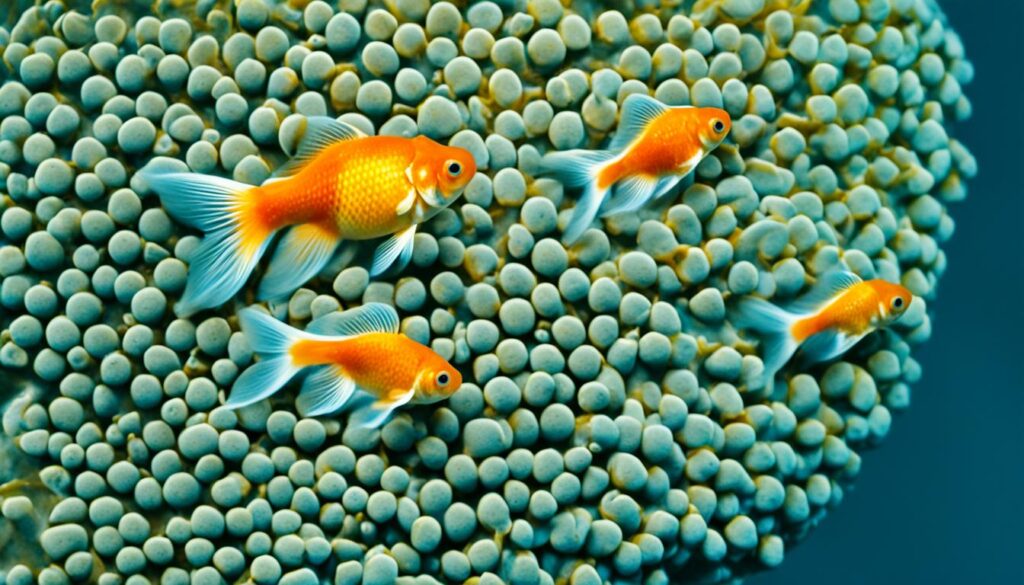
Polycystic kidney disease is a severe condition found in goldfish. It leads to cysts in their kidneys, causing tissue damage. This disease is important to understand for those caring for these fish.
Even if goldfish look okay, they might be suffering from this disease. They can get very swollen. It’s necessary to use tools like ultrasound to find kidney cysts. Spotting these signs early is key, to help make life better for them.
Below is a table with studies on PKD. It helps us know more about the disease and how to shield goldfish from it:
Study Focus |
Findings |
Relevance to PKD |
|---|---|---|
Hexachloro-butadiene nephrotoxicity |
Post-exposure, goldfish showed significant cell proliferation in kidney tissues, leading to cyst formation within 70 days. |
Indicates potential environmental or chemical triggers leading to PKD. |
Aberrant epithelial cell proliferation |
Responsible for cyst formation in autosomal dominant PKD cases, driven by fluid accumulation. |
|
Pathogen-induced PKD |
Studies in Austria and Iceland documented outbreaks affecting local fish populations, with ongoing effects. |
Underscores the infectious nature and potential spread of PKD in wild conditions. |
PKD resistance studies |
Inquiries into PKD resistance in rainbow trout could provide insights into potential genetic or immunological defenses. |
Contributes to understanding potential resilience factors that could be encouraged in goldfish populations. |
Polycystic kidney disease poses a big risk to goldfish. It’s key to use this info in their care. With the right knowledge and effort, we can really help these fish.
Parasites
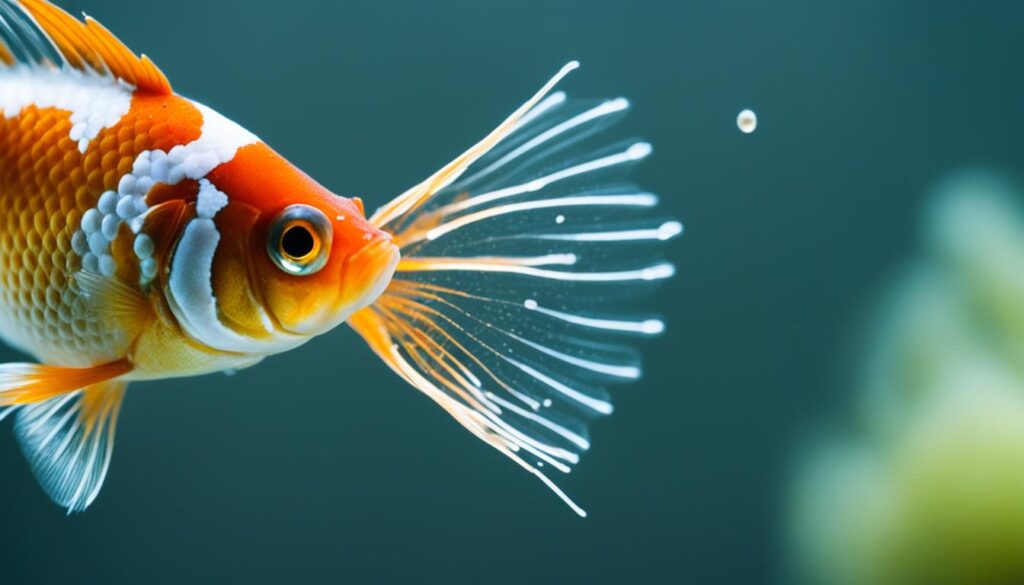
Every goldfish owner should learn about goldfish parasites. They include tiny worms and crustaceans that harm fish health. Fish often catch parasites from their surroundings. This is especially true in pet stores where fish tanks are close together. It increases the chance of parasite spread. Getting new fish or exposure to pond wildlife also ups the risk.
Symptoms of external parasites include Velvet, white spot (also known as Ichthyophthirius), Anchor Worms, and Gill Flukes. On the flip side, internal parasites like Tapeworms and Roundworms cause tiredness, weight loss, and color change.
To fight goldfish diseases from parasites, clean gravel and change water often. Adding the right amount of anti-parasite meds is key. Remember, these often contain copper, which is great against parasites but bad for other tank life.
If you see parasites like Anchor worms or Fish lice, you might have to pick them off. Use tweezers and wear gloves to protect yourself and the fish.
Parasite Type |
Common Names |
Life Cycle Complexity |
Typical Treatments |
|---|---|---|---|
Protozoa |
Ich, Trichodina |
Simple |
Anti-parasitic meds |
Trematodes |
Skin Flukes, Gill Flukes |
Complex |
Targeted parasite treatments |
Crustaceans |
Anchor Worms, Fish Lice |
Intermediate |
Physical removal, Medicated baths |
For a healthy tank, check water quality regularly and quarantine new fish. These steps help prevent common goldfish diseases. They keep your fish healthy and free from parasites.
Swim Bladder Disease
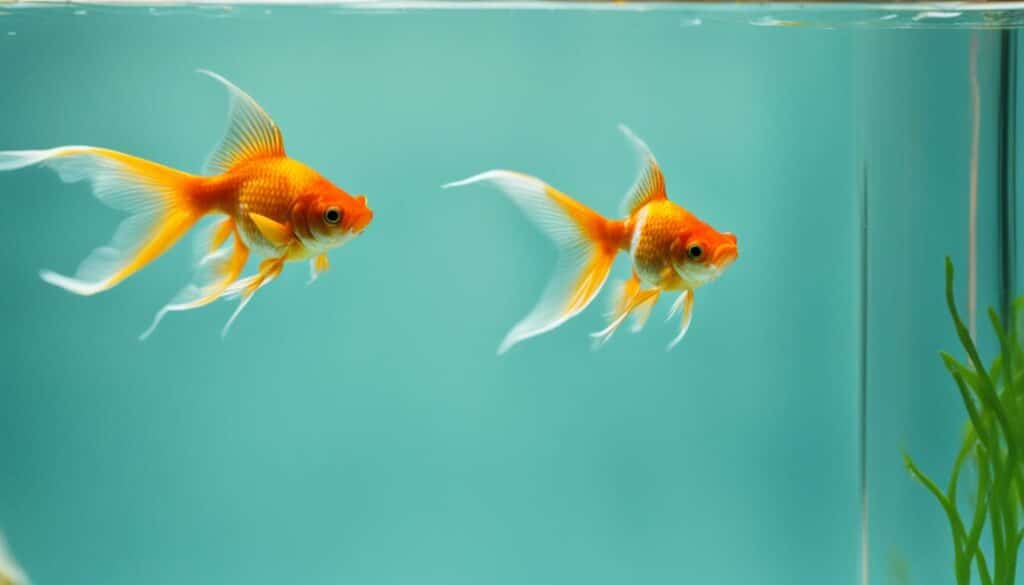
Dealing with sick goldfish means knowing about swim bladder disease. It’s common in fancy goldfish due to bad water, too much food, or injury. I’ll tell you how to spot, treat, and stop this fish disease.
Swim bladder disease messes with a fish’s buoyancy control. It’s not just one problem but several that hurt the swim bladder. This organ lets fish swim easily. Catching symptoms early, like a swollen belly or floating weird, helps a lot.
Figuring out swim bladder disease means checking the fish well. A vet might need to use X-rays to see the swim bladder. It’s key to know if it’s from bad food, germs, or birth defects.
Here’s what you do for treatment:
- No food for three days if the fish is bloated.
- Give peas without skins to fix constipation and then feed good food.
- Keep the water clean and at the right temperature.
- Use antibiotics for bacterial infections.
Since it usually comes from the environment, it doesn’t spread but isolate sick fish to help them heal without stress.
Stopping swim bladder issues before they start is key. Do this with clean tanks, right feeding, and stable water temperature. This keeps problems away.
Catch fish diseases early for the best chance to fix them. Watch your fish for any strange actions. If things don’t get better, a fish vet can offer help and new treatments.
To wrap up, swim bladder disease sounds scary, but knowing about it puts you in charge of caring for your goldfish properly.
Effective Treatment Methods for Sick Goldfish
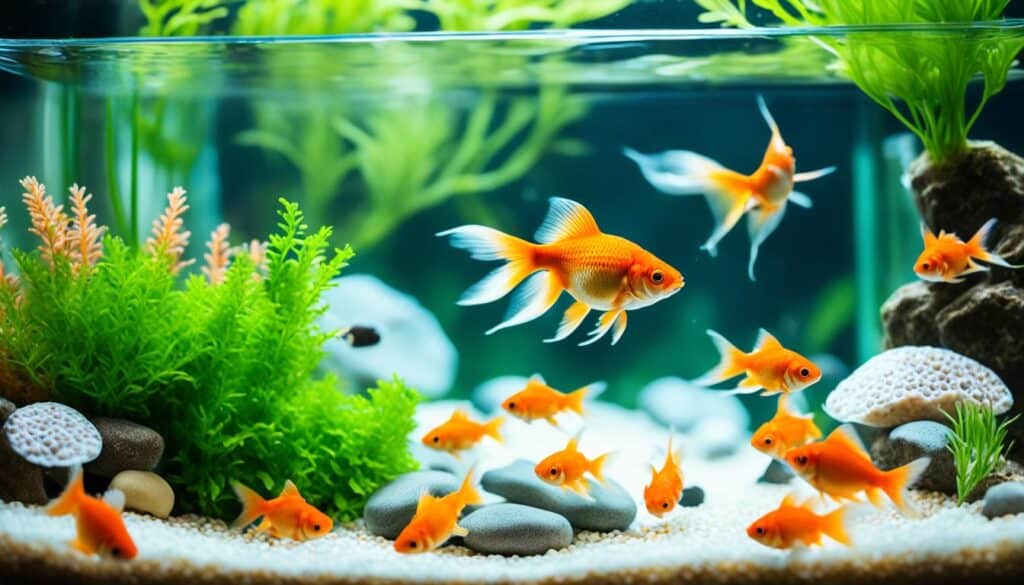
Dealing with treating sick goldfish might seem hard due to many common freshwater fish diseases. Yet, knowing the goldfish illness symptoms early helps a lot. In this section, you’ll learn about effective methods to fight these illnesses.
First off, knowing if the disease is bacterial, viral, or parasitic helps in choosing the right treatment. For example, bacterial infections need antibiotics, while parasites need treatments like Praziquantel. It’s key to know the disease to pick the best solution.
For daily care and small issues, adding aquarium salt to the water can soothe inflamed gills and fight off parasites. For worse problems, using Methylene Blue and Epsom salts is advised. Methylene Blue fights fungi and some bacteria. Epsom salts help with digestion and swim bladder issues.
Keeping the water clean is very important as bad water causes diseases. Changing the water often and checking it for toxins are necessary steps. Putting new or sick fish in quarantine helps stop the spread of diseases.
- Maintain water quality by routinely changing the aquarium water and testing it for harmful substances.
- Quarantine new arrivals for at least two weeks to monitor signs of distress or disease.
- Use specific treatments like Praziquantel for parasites and Methylene Blue for bacterial and fungal infections.
In summary, treating sick goldfish well means spotting and knowing the illness early, then treating it correctly. Watching and keeping the tank clean are just as important. By doing these things, your goldfish can stay healthy and happy.
Quarantine Protocol for Sick Fishes

Quarantining new or sick goldfish is crucial. It’s more than a simple precaution in the aquatic pet world. As a goldfish lover, I’ve learned that a quarantine tank helps prevent goldfish diseases. It keeps the fish tank healthy. This method protects all fish by giving sick ones a safe place to heal.
Importance of a Quarantine Tank
A quarantine tank is vital for fish health. It’s known that new fish can bring diseases from their previous homes. Quarantining lowers this risk. Having a separate tank means treatments like Mardel Maracyn, Aquarium Solutions Ich-X, and Fritz ParaCleanse can be used safely.
Steps for a Successful Quarantine
Setting up a successful quarantine requires careful planning and care for goldfish health. Follow these steps for an effective quarantine sick goldfish process:
- Setting up the Quarantine Tank: Match the main tank’s environment to reduce stress for the goldfish. This includes water temperature and pH levels.
- Medication Protocol: Start with broad-spectrum medications for unseen infections.
- Observation: Watch the fish daily for at least two weeks. Look for any changes, and adjust treatment if needed.
- Water Quality Management: Keep the water clean with regular changes. This is key for the goldfish’s recovery and health.
Let’s look at the steps’ benefits in the following table to understand their importance:
Step |
Action |
Benefit |
|---|---|---|
1. Tank Setup |
Replicate main tank conditions |
Reduces stress and acclimates fish |
2. Apply Medication |
Dose with Maracyn, Ich-X, ParaCleanse |
Pre-empts and treats infections |
3. Observation |
Monitor health and symptoms |
Enables timely intervention |
4. Maintain Water Quality |
Regular water changes |
Supports immune system and recovery |
By following these steps, you help goldfish heal and prevent diseases. It’s crucial for a goldfish health guide to stop disease spread. This proactive stance ensures healthy fish. By doing this, you protect all aquatic life in your care.
Prevention Strategies
In my quest for a thriving aquarium, I’ve learned that stopping diseases before they start is key. This method keeps the peace in my water world. Making sure the water is clean is vital for goldfish health. By keeping Nitrate levels low, we can avoid fin rot. Regularly changing the water and checking its quality keep diseases away from my goldfish.
Feeding my goldfish is more about health than just survival. Adding Intan Fish Food to their diet helps boost their immune system. This food is packed with proteins, fats, vitamins, and essential vitamins like C and E. This mix helps them fight off infections. Stress can also lead to health issues. So, I keep their home peaceful and their diet balanced to prevent illnesses such as Ich or Velvet.
Quarantine is important for avoiding goldfish diseases, not just for humans. I watch new fish for two weeks to stop diseases from spreading. Thanks to these steps, I avoid overcrowding and stress for my goldfish. My role is much like a guardian’s, where being watchful, caring, and ready to act keeps my fish healthy and strong.
